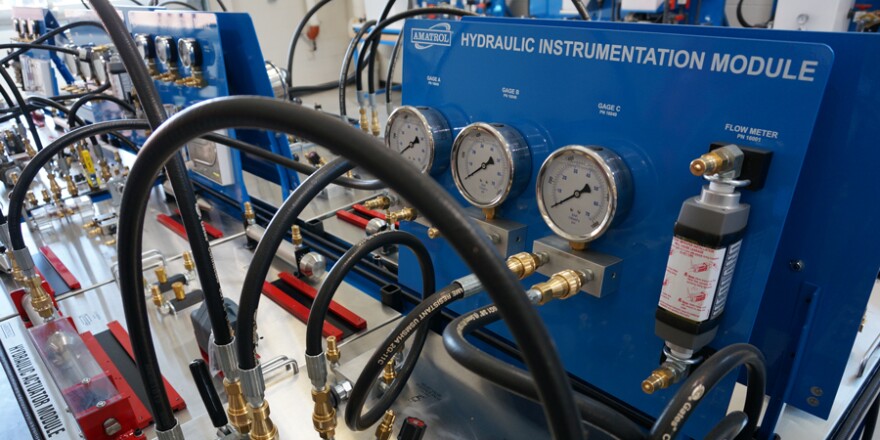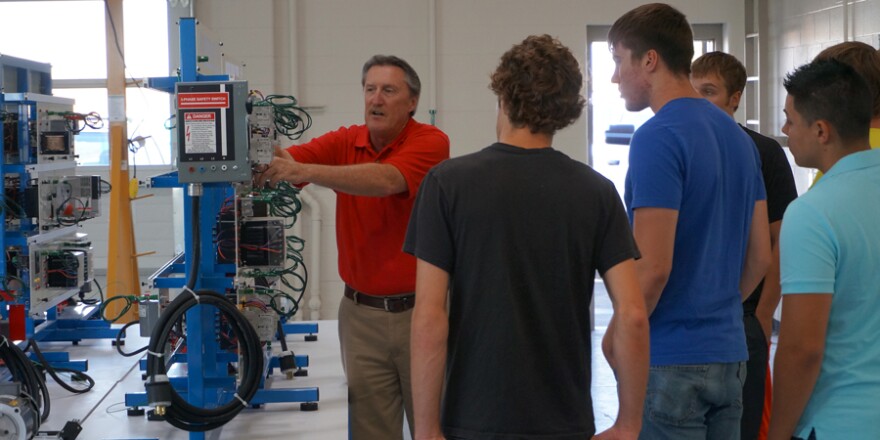In Colorado, the oil and gas industry employees nearly 30,000 people in the field ŌĆō and theyŌĆÖre looking for more.
has been working in collaboration with some of the industryŌĆÖs biggest players like , and to develop its oil and gas program. Oil and gas production broke a 50 year in 2012, and itŌĆÖs on pace to do so again. Aims is hoping to create a pipeline of qualified workers to meet those production needs.
ŌĆ£From the oil operators, to people like us, the drilling contractors, to support service contractors, we are in a desperate strait for new employees, new workers,ŌĆØ said Cliff Roberts, an engineer with the Canadian-based drilling company Ensign. ŌĆ£A lot of workers are retiring, some people leave, so itŌĆÖs almost an unlimited demand with a short and limited supply.ŌĆØ
ThatŌĆÖs where AimsŌĆÖ director Bruce Beardsley comes in. Now in its second year, the program is taking advantage of a new, $10 million facility complete with hydraulic pipe trainers and hands-on rigging equipment.
He says with in-depth help from energy companies in the region, Aims developed the programŌĆÖs curriculum after it secured a $2 million grant from the . ŌĆ£TheyŌĆÖre the experts; they know what they want to see in their new hires,ŌĆØ said Beardsley. ŌĆ£So we want to give them what they want.ŌĆØ

The funding is part of a $17 million federal grant distributed to 15 colleges across Colorado. The has taken the lead on the grant. Casey Sacks, the grantŌĆÖs project manager, says the goal of the programs is to help people who lost jobs in the great recession.
ŌĆ£The Department of LaborŌĆÖs trying to facilitate partnerships between energy related businesses, colleges and work force centers so that we can train unemployed and underemployed workers,ŌĆØ said Sacks.
ThatŌĆÖs music to the ears of new student Michelle Brumagin of Loveland.
ŌĆ£IŌĆÖve been teaching in public school for 20 years so IŌĆÖm doing a career re-evaluation,ŌĆØ said Brumagin. Her interest in joining the growing industry is purely economic. After struggling to make ends meet, sheŌĆÖs hoping to join an industry with a proven track record of steady wages.
ŌĆ£I think because whatŌĆÖs happening in the area and itŌĆÖs something thatŌĆÖs always gonna be there,ŌĆØ said Brumagin. ŌĆ£And then I think just the whole thing that oil and gas takes care of their people and they actually get paid for what they do. Their money is more reflective of what they put into it.ŌĆØ

Money is also a factor for 19 year old Wyatt Herbert from Berthoud.
ŌĆ£Because itŌĆÖs a growing industry and thereŌĆÖs gonna be a lot of money going on in it and yeah,ŌĆØ Herbert says, ŌĆ£I just wanna get into it.ŌĆØ
Wages vary by company, but workers in the field can make between $22 and $28 .
While Herbert and Brumagin are banking on the future of the oil and gas industry, there is some immediate uncertainty. Voters in Front Range communities will decide the fate of moratoriums or bans of hydraulic fracturing at the ballot box.
Program director Bruce Beardsley says heŌĆÖs not focused on the politics of the industry; heŌĆÖs intent on giving students the tools they need to work in the industry safely. ŌĆ£You know weŌĆÖre not here to argue the good points and bad points of the oil and gas industry,ŌĆØ said Beardsley. ŌĆ£WeŌĆÖre here to teach them the proper skills so they can put them to work the right way.ŌĆØ







